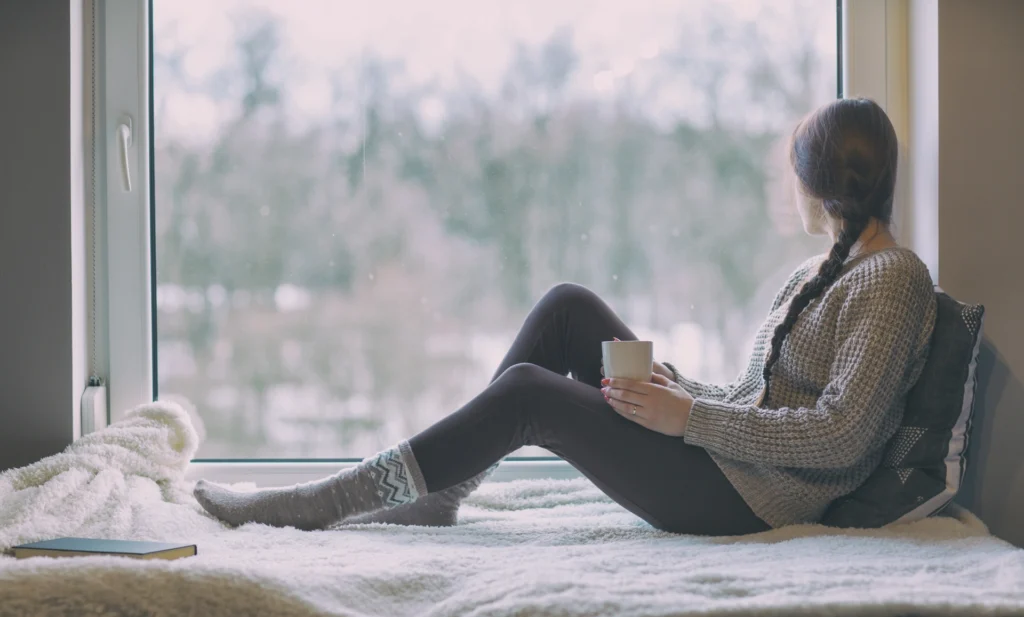As a happy, free-spirited college student, winter depression was far from my train of thought. In fact, I was in college when I first heard the term, “Seasonal Affective Disorder.” What in the world was that? It was winter in the Midwest. I had lost enough weight it was noticeable. I was having unexplainable crying jags. I didn’t understand — I loved college and the newfound freedom and opportunity it afforded me. I had good friendships and good grades. I was getting by but at what cost? I went home for the weekend in hopes that some TLC in the comfort of a familiar space would snap me back to “me.” My parents were consistently loving and supportive of me. However, I grew up in a family that dismissed feelings and often told me, “…stop feeling so much.” That never helped. (It should be noted that telling someone to stop feeling is like pushing a beach ball under water and wondering why it floats again?!) Regardless of their discomfort with my feelings, my parents stood by me, figuratively and literally. My dad suggested we visit a natural supplemental pharmacy that had recently opened in our community. There I was told I had Seasonal Affective Disorder or SAD. Having an explanation as to why I was feeling this way brought relief. I was prescribed Vitamin D and other natural supplements. Taking them allowed me to experience some relief of my symptoms. My dad walking into that unknown time with me and taking me to the pharmacy did bring me a certain dose of healing, in itself. Even today, I am comforted when I recall this story… a reminder that presence matters.
Fast forward to today…what do we know about seasonal depression? SAD begins and ends about the same time of year, often beginning in the fall and continuing through the winter months. It often zaps our energy, interrupts our sleep cycles, produces weight changes, and makes us feel moody or empty inside. It’s important to note this has nothing to do with not being a grateful human being. According to the Mayo Clinic, SAD is primarily due to the lack of natural sunlight in winter months. This leads to a disruption to our internal clock and can play havoc with the hormones that often trigger depression. In the winter, light threshold falls, and we can suddenly feel off balance. Less sunlight and shorter days are linked to a chemical change in the brain. When days are shorter and the darkness lingers, our bodies naturally make more melatonin, a sleep-related hormone. Due to the decreased winter sunlight, communities located further from the equator experience SAD much more frequently. It’s estimated 10% of the people in the United States deal with SAD with women being 4X more likely to experience the symptoms than their male counterpart.
SAD symptoms include:
· Increased sleep and daytime drowsiness
· Loss of interest and pleasure
· Social withdrawal
· Irritability, anxiety, or sadness
· Feelings of guilt or emptiness
· Fatigue
· Decreased ability to focus
· Decreased sex drive
· Increased appetite, especially for sweets and carbs
· Changes to weight
· Headaches
Personally, my SAD symptoms vary year to year. In an effort to alleviate symptoms and increase my coping skills, I’ve found a few things that work well for me. I’ve incorporated a regular rhythm of travel to the hot sun at the beginning of winter. As with any illness, it’s important to remember stress plays a role in the intensity of symptoms. With that in mind, I adjust my expectations of myself in the winter — allowing for more rest, reflection, and renewal. Reaching out to supportive friends and family help soothe and comfort me when feeling a low mood. Light therapy as part of my morning routine has helped increase my exposure to light and Vitamin D. I add a Vitamin D supplement to my diet for the latter part of the year. In addition, regular exercise and being mindful of consuming nutritionally dense produce help alleviate some of the symptoms. On winter days when the sun does shine, I take time to savor and enjoy it. I’ve found ways to positively engage with winter — a bundled up hike with my dog, sitting by a fire outdoors with a hot drink, skiing, sledding with my kids and neighbors. Research has long shown that simply going outdoors can boost our mood. Should the severity of symptoms increase, antidepressants and cognitive therapy can also be helpful.
Every single one of us is fighting some sort of challenge — challenges ebb and flow throughout various seasons of life. For now, may we embrace the quietness and rest that winter offers. May we give ourselves the self-care and medical care needed to continue to Learn2thrive in all life’s different seasons. As they say, “You can cut all the flowers down but can’t keep spring from coming.”


